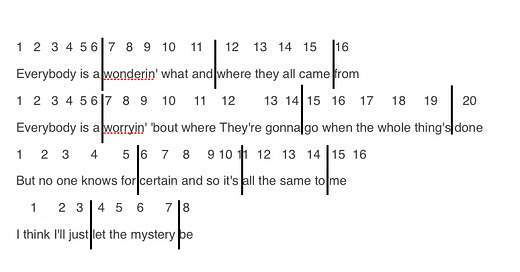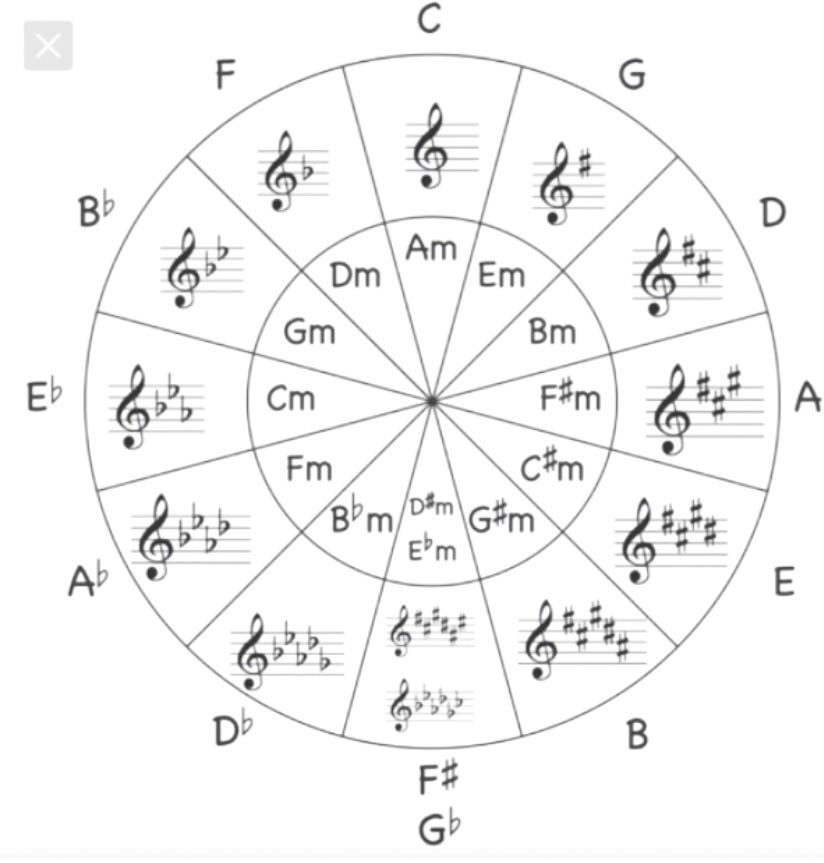Yesterday’s Bonus Round: “From Clare to Here" is a ballad about Irish emigration written by Ralph McTell in the 1970s, and covered beautifully by the late Nanci Griffith from her 1993 album “Other voices, Other rooms”, for which she won a Grammy in 1994.
OK, let’s get right to it!
Here is my take on the syllable count and phrasing of Iris Dement’s song “Let The Mystery Be” that we’ve been analyzing:
Here’s the Ultimate Guitar chord chart for the same chorus section:
When I “phrased out” the lyrics I was listening for where she placed the emphasis as she sang the lyrics, and I heard the “E” sound in the word “Everybody”, and the words “wondering”, “where” and “from” emphasized more than the surrounding words. I heard the first word after the vertical “phrasing line” I placed in the subsequent lines emphasized as well. Am I right? Dunno, others will maybe hear something different, and the author of the UG chord chart thought the words “they’re gonna go” signaled a new line. It sounded to me like one thought, though that did make the line longer in words and syllable count than the others. Though I play this song often, it’s been a while, so I purposely didn’t note chord change locations until today in order to compare with my phrasing. I’m reasonably happy with my results here, by depending on emphasized words, especially in light of this phrasing definition from a previous post: “Short section of music of a musical composition into which the music, whether vocal or instrumental, seems naturally to fall.” Each line as I’ve phrased above seems to make a complete thought that complements and supports the idea conveyed by the chorus as a whole, and the chord changes (remember chords support melody, but aren’t the melody itself) fit reasonably well with my phrasing. As well, it fairly closely follows what I heard as the lyrical “rhythm” of the song - not every line has the same syllable count or internal phrase length and that helps establish a kind of rolling, natural sounding, and pleasing rhythm. Others, especially more experienced and learned musicians than I, may very well see something different, and I’d love to sit down with them, or preferably Ms. Dement herself (over the beverage of her choice, of course) to discuss the differences. Alas, probably another wish not to be fulfilled. One of the first questions I’d have is if she wrote the music first, then adapted lyrics, or lyrics first and fit the music around them. An interesting conversation indeed, I’m sure.
Anyway, that’s the basic idea behind analyzing phrases within lines, lines within sections (chorus, verse, bridge) and how they all fit together with the melody and chording (and percussion, bass, and melodic accompaniment) to make an interesting song. Try it yourself without looking at the chord and melody structures by analyzing just the lyrics - finds them on the Genius Lyrics app, or just via a web search, and phrase them as you hear them, listen to the song on YouTube or Spotify or somewhere, then compare to the chord chart on Ultimate Guitar or Chordify. Close counts!!
So, on to this monster, as promised:
Let’s start with a simple observation: the key signatures found in the second ring in, and how it relates to the letters and symbol combinations found in the outer ring. Let’s start with the Key of C, indicated at the very top. CMaj is the key with no sharps or flats, so there is no symbol following the treble clef in the signature just below the C that correlates to the key. Clockwise to the right is the Key of G, and since there is one sharp note in the GMaj key signature, it correlates with the GMaj scale that has one sharped (#) note. Which chord in the key of GMaj, is rooted on the only sharped note in the GMaj scale?
The F# 7th is the only sharped note in the scale, thus the F#° (F# diminished) vii° chord is the only chord in the key rooted on a sharped note. Remember, a sharped or flatted chord root note doesn’t make the chord Major, minor, or diminished, only it’s position in the key - and that position is what changes the 3rd or 5th notes of the chord triad to make it something other than a Major chord. Still with me?
For today, let’s just say the letters around the outer ring indicating scale/key, correlate to what you’ll find in the key signature (as we learned about last week) found in the second ring in, and so are handy as a guide to determine what key you’re playing in if you happen to have only a scored notation of the song available.
As we move along, we’ll learn much more about the relationships between the order of the scales/keys indicated in the outer ring with each other and not just the inner rings, -though there’s plenty of that, too. Told ya - it’s an abyss!!
Finally, today we’ll talk about counting, and why a time signature is important for how we count as we play or sing with a song. Remember I said 4/4 time is also known as “Common Time” often seen in modern music, and we see it in the time signature as 4/4, or maybe just a capital C. Both indicate the same thing: 4 beats to the measure, each quarter note gets a beat. How do we count a “measure” if we just play quarter notes? Not surprisingly, it’s “1-2-3-4”. But measures can contain a variety of types of notes, in a variety of combinations. What if all the notes were “whole notes? Count: “1”. Half notes? “1-2”, Eighth notes? “1and2and3and4and”,. Sixteenth notes? “1-e-and-a-2-e-and-a-3-e-and-a-4-e-and-a”. Much past that is probably not helpful - you’ll be spending more concentration on counting than playing at almost any tempo. And tempo is the factor that allows you to learn a fast song. If you can count the eighth or sixteenth note beats as you strum or pick at a slow tempo, as you develop the muscle memory needed, you can speed up to Mark Knopfler or Eddie Van Halen territory (maybe you, not me…).
Ok, practice counting, if you need a place to start, try that piano intro from last week’s Bonus Round song “How To Save A Life” by The Fray!!
Bonus Round: A older hopeful song, kinda Christmas themed, but maybe not, by a baby sound, well known, rock/pop band. (I think this will be pretty easy, and we could all use something hopeful for 2022!!)
Cheers, and keep playing!!
Michael Acoustic








